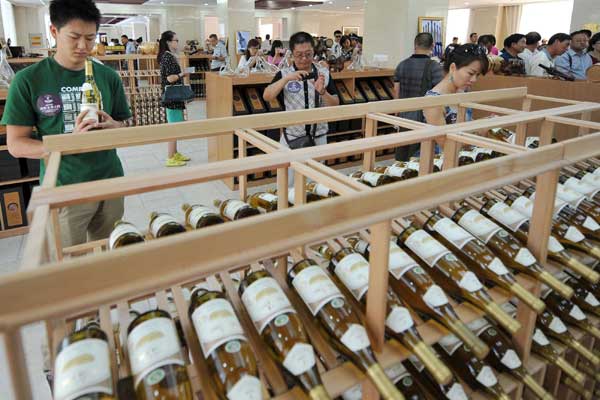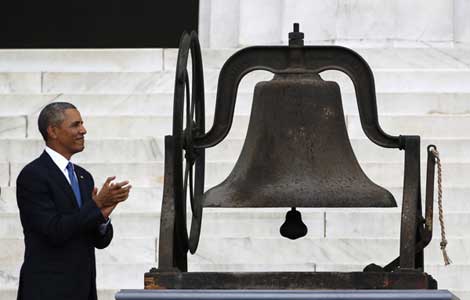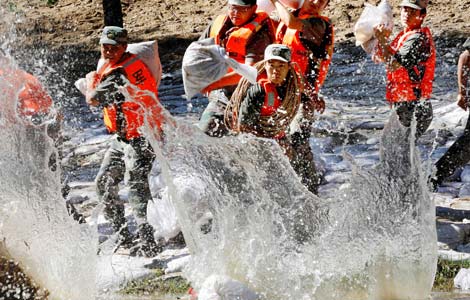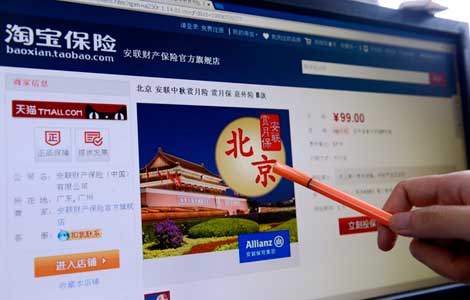
Leading Chinese vineyards are constructing chateaus at a furious pace as they strive to catch up with world-famous premium wineries whose products are pouring into the nation, sparking concerns of a boom that may go bust.
There are already more than 160 chateaus in China, and about 200 more are under construction.
 |
|
Customers pick wines at a chateau in the Ningxia Hui autonomous region. Changyu has a wide assortment of vineyards in six regions across China, including Ningxia.[provided to China Daily] |
The latest was opened by leading winery Yantai Changyu Pioneer Wine Co Ltd in the Xinjiang Uygur autonomous region on Aug 12.
The 630 million yuan ($103 million) Chateau Changyu Baron Balboa in Shihezi includes a 6,000-square-meter cellar, production facilities, a museum and a 37-hectare vineyard. It is expected to produce 1,000 tons of wines every year.
"Wine chateaus are the basic prerequisite for premium wines, so Changyu is building six chateaus in different grape-growing areas across China," said Zhou Hongjiang, general manager of the company.
Zhou said the Xinjiang chateau will be the company's wine production base in the western part of China.
"Chateaus are playing an important role in upgrading the structure of China's wine industry," said Wang Yancai, head of the China Alcoholic Drinks Industry Association.
"Chateau Changyu Baron Balboa has the ability to compete with European first-class chateaus. It won't be long until the chateau and the Xinjiang area gain the wine world's attention," Wang said.
The Xinjiang chateau is meant to be a tourist destination that will offer services associated with wine, such as experiencing wine culture and providing a venue for high-end conferences.
The company also plans to build a European-style town and a wine trade center at the Xinjiang chateau, with completion scheduled for 2016.
After four years of planting and cultivating grape vines, Changyu has 4,666 hectares of vineyards in Xinjiang.
The abundant sunshine and huge day-night temperature differentials result in grapes with more sugar content, making the area one of the best places in China for quality grapes.
Competition
Count John U. Salvi, the honorary president of the chateau, said that wines made from the grapes are competitive with New World wines, such as those from Australia and the United States.
The Xinjiang chateau is the company's fourth. The management of Changyu was inspired to build China's first chateau in Yantai in 2002 after an analysis of the wine industry in France.
There, more than 80,000 wine chateaus play an important role in France's fame as a global wine player, according to Li Jiming, Changyu's chief engineer.
Today, Changyu has a wide assortment of vineyards on 20,000 hectares of land in six regions: Shandong, Shaanxi and Liaoning provinces, the Xinjiang Uygur and Ningxia Hui autonomous regions, and around Beijing.
There will be six chateaus in six areas, with four already operating.
Chateau Changyu Moser XV in Ningxia and Chateau Changyu Reina in Shaanxi province are scheduled to open to the public in the coming months.
"Wines made in the six chateaus cater to a wide range of consumers. Some can be served at home, while others are suited to national banquets, and some exquisite varieties can be collected as an investment," Li said.
"Chateau wines are Changyu's most competitive products, boasting annual average sales growth of 45 percent since 2008," said Sun Jian, deputy general manager of Changyu.
Li, the engineer, said Changyu has chosen to join forces with the world's most prestigious chateaus to build its chateaus in China. The idea is to ensure premium quality.
Chateau Changyu-Castel was built in 2002 in cooperation with the Castel Group of Bordeaux, France.
Five years later, with the participation of vintners from France, the US, Italy and Portugal, Changyu spent 500 million yuan to establish Chateau Changyu AFIP Global in Beijing's Miyun county.
The same year, an ice wine chateau in Liaoning province was built in cooperation with Aurora Icewine Co Ltd, the biggest ice wine company in Canada.
Chateau Changyu Moser XV has been jointly developed by Changyu and the Austrian winemaker Lenz Moser, whose family has run wineries for 15 generations.
Changyu chateau wines have been winning over European consumers. Last year, Changyu Jiebaina was put on the shelves of Waitrose Ltd outlets in the United Kingdom.
Although Waitrose didn't continue to sell the wine after the trial, a spokesman said that the Changyu Jiebaina was selling out "quickly, much faster than we expected, and we were thrilled with our customers' reaction to this new and unknown wine", according to wine publication Decanter.
This March, Berry Brothers & Rudd, Britain's oldest wine merchant, announced it will permanently stock four Changyu wines: Chateau Changyu Moser XV and three ice wines.
Changyu plans to expand its chateau portfolio by building a "wine city" in its home base of Yantai in 2016, where it will invest about 6 billion yuan.
Besides two wine and brandy chateaus, the "wine city" has a research institute, wine production center, a vineyard, a European-style village and an international wine trading center.
Growth
The number of chateaus in Yantai will reach 150 by 2015, according to the Yantai Vine and Wine Office.
Besides Chinese wine heavyweights like Changyu, China Great Wall Wine Co Ltd and Dynasty Fine Wines Group Ltd, alcoholic drinks maker Kweichow Moutai Co is constructing a wine chateau.
However, industry experts said building and running a chateau in China isn't easy.
"Chateau builders may face crucial challenges from domestic and foreign wine heavyweights as they don't have parallel advantages in grape growing, wine-making techniques and marketing," said Li Hua, professor at Northwest Agriculture and Forest University.
Last April, Domaines Barons de Rothschild, Chateau Lafite's parent company, teamed up with CITIC Capital Holdings Ltd, China's largest State-owned investment company, to build a chateau in Penglai, a city on the easternmost tip of Shandong, one of China's largest wine-producing areas.
The vineyard around the chateau will reach 50 ha, which can produce 20,000 bottles of wine in its first production year, set for 2016.
More than 90 percent of the wines produced here target the Chinese market.
Data from the National Bureau of Statistics show that the sales volume and net profit of domestic wine producers declined in the first half of this year.
Meanwhile, Chinese customs figures show first-half wine imports rose 20.9 percent to 140.6 million liters, and the value of imported wines rose 8.2 percent to 535.3 million euros ($713.34 million).
The declining demand for domestic wines is casting a shadow on chateau development in the nation.
For example, Beijing's Yanqing county announced in July that it had stopped work on 40 of the 44 chateaus it had planned to build for next year's 11th International Conference on Grapevine Breeding and Genetics.
Li suggested that any vineyard planning to build a chateau should construct something unique, instead of just copying overseas facilities.
Lyu Chang contributed to this story.
Contact the writers at juchuanjiang@chinadaily.com.cn and zhaoruixue@chinadaily.com.cn.








